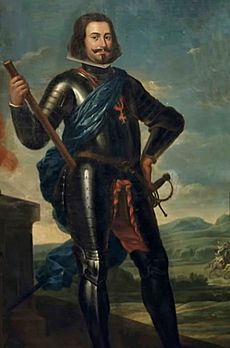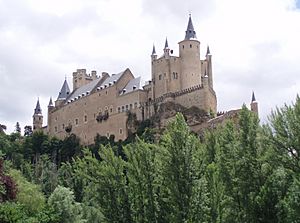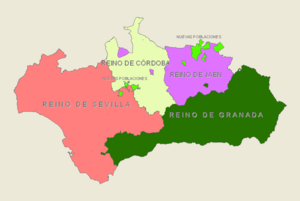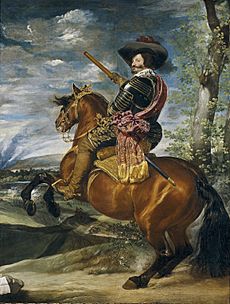Andalusian independentist conspiracy (1641) facts for kids
The Andalusian Conspiracy of 1641 was a secret plan by some powerful nobles in Andalusia, a region in southern Spain. They were accused of wanting Andalusia to break away from Spain and become independent. This alleged plot was discovered in the summer of 1641, and it quickly ended.
The main people accused of leading this conspiracy were Gaspar Alonso Pérez de Guzmán, the Ninth Duke of Medina Sidonia, and Francisco Manuel Silvestre de Guzmán, the Sixth Marquis of Ayamonte. Many believed they wanted to start a rebellion in Andalusia against King Philip IV of Spain. Their goal was supposedly to make the Duke of Medina Sidonia the new king of an independent Andalusia. He came from one of Spain's oldest and most important noble families.
Even after more than 350 years, many parts of this event are still unclear. People still debate whether a real conspiracy actually happened.
Contents
Was There a Real Conspiracy?

Since the conspiracy was stopped early, the true reasons and ideas of these Andalusian nobles are not fully known. The common belief is that these nobles wanted more power for themselves. They might have joined a movement to separate from Spain, similar to what happened successfully in Portugal and for a while in Catalonia.
Another idea is that they wanted to remove the king's powerful advisor, Gaspar de Guzmán, Count-Duke of Olivares. They might have aimed to solve Spain's money problems, lower taxes, and improve Andalusia's situation for King Philip. Their plan might have been a coup d'état (a sudden takeover of government) starting in Andalusia. However, it might not have been about making Andalusia independent.
Luisa Isabel Álvarez de Toledo, a descendant of the Duke of Medina Sidonia, has another theory. She believes there was no conspiracy among these nobles at all. She suggests that the Count-Duke of Olivares made up the whole story. He might have been jealous of the Duke of Medina Sidonia's power and influence. The Count-Duke's family was a smaller branch of the Duke's family.
According to this theory, the Duke of Medina Sidonia did not attack Portugal because the Spanish army was very weak. There were only about 3,000 soldiers on the Huelva border.
Key People in the Alleged Plot
Gaspar Alonso Pérez de Guzmán

The Ninth Duke of Medina Sidonia was the main person accused of plotting against King Philip IV. His family, the House of Medina Sidonia, was the most important noble family in Andalusia. They were known for their long history and huge wealth. He became Duke in 1636 when his father died. At that time, he was 33 years old.
Even with his family's great wealth, the Duke's own finances were in trouble. He had borrowed a lot of money. He spent a lot before his father died, living a very fancy lifestyle. For example, he hosted King Philip IV with great luxury in 1624 at the Coto de Doñana.
As Duke, Gaspar Alonso was also the military leader for the coasts of Andalusia. This made him the military governor of the region from the Guadiana River to the Strait of Gibraltar. In this role, he was supposed to fight against the Portuguese rebellion in 1637. This rebellion was led by the Duke of Braganza (who later became John IV of Portugal). Interestingly, the Duke of Braganza had married Gaspar Alonso's sister, Luisa de Guzmán, in 1632.
Francisco Manuel Silvestre de Guzmán
Francisco Manuel Silvestre de Guzmán y Zúñiga was the Sixth Marquis of Ayamonte. He was also a member of the powerful Guzmán family, but from a different branch. Born in 1606, he inherited a small estate with limited money. He spent so much that by 1636, the Council of Castile had to manage his income. He also took part in fighting against the rebellious Portuguese.
Portugal's War and the Guzmanes
The Portuguese Restoration War was about Portugal regaining its independence. While it was separate from the Andalusian plot, it's important to understand both together.
Many people believe that the Andalusian plot and the Portuguese uprising supported each other. The Marquis of Ayamonte supposedly told his relative, John, Duke of Braganza, about Spain's plans to retake Portugal. In return, the Portuguese king offered to help Medina Sidonia and Ayamonte. Their goal might have been to conspire against the Count-Duke of Olivares, not necessarily against the King of Spain.

If the plot had not been discovered, it might have succeeded. Olivares' army was very weak. The Portuguese revolution happened on December 1, 1640. The Andalusian conspiracy was found out in the summer of 1641. The close timing suggests that there was indeed a plot with Portuguese support.
The first Portuguese uprising began on August 21, 1637. It was stopped in early 1638 by Margaret of Savoy. She was the Vicereine (the king's representative) and niece of Philip II of Spain.
A new uprising happened in 1640. Portuguese nobles killed Miguel de Vasconcelos, took the vicereine prisoner, and crowned John of Braganza as king of Portugal. This established the House of Braganza, which ruled Portugal for the next two centuries. After December 1, 1640, King Philip IV and Olivares began to plan to retake Portugal from the Ayamonte border.
In Madrid, the Duke of Medina Sidonia was made captain general of an army. This army was supposed to attack the Portuguese from Andalusia. The Duke went to Ayamonte, set up his headquarters, and ordered an army of ten thousand men to gather. However, the army gathered very slowly. The Duke even refused troops sent by the Assistante of Seville, saying the army needed more supplies from Madrid. This seemed like a strange attitude. It was assumed he only accepted 3,000 troops to guard the border because his sister was now the Queen of Portugal. His slow actions certainly did not help the few nobles in Portugal who supported Spain.
Suspicions grew that the Duke was planning his own uprising to separate Andalusia from Spain. According to the common story, the idea first came from the Marquis of Ayamonte. He was connected to the Duke through a series of contacts. The plan relied on support from Portugal and help from the French and Dutch navies.
Following this version of events, there were many secret trips across the Portuguese border. Serious rumors about Ayamonte began to spread. In the summer of 1641, a special messenger from Madrid, Antonio de Isasi, found a letter from Ayamonte to Medina Sidonia. He sent it to the court, and the letter revealed the plot.
Other people who gave information to the court about the conspiracy were Fray Nicolás de Velasco and Fray Luis de las Llagas. Francisco Sánchez Márquez, a government official, also gave a statement. He said that while in prison in Portugal, he heard a conversation between Fray Nicolás de Velasco (who was pretending to be a prisoner) and a mason. The mason had overheard two servants in the Duke of Braganza's palace talking about a fleet preparing to attack Cádiz. When Márquez was freed and returned to Castile, he told everything to the Count-Duke of Olivares.
The Conspiracy Revealed
According to the common story: While Medina Sidonia and Ayamonte waited for news from Portugal about the French-Dutch fleet, the Duke was called to court. He made excuses, saying he was sick, to gain time. News from Portugal suggested the fleet would arrive soon. He used the extra days to contact other nobles like Rodrigo Ponce de León, 4th Duke of Arcos and the Duke of Infantado. He asked them about a possible uprising.
However, these nobles refused to join. They saw it as a lost cause because there wasn't enough support among the nobility. Also, the common people, despite some unhappiness, did not rebel, even with supposed support from Seville and Jerez de la Frontera. The French and Dutch fleets also failed to arrive.
Luis de Haro, who later became the king's main advisor after Olivares, was sent from the court to Andalusia. His job was to find out how widespread the plot was and to arrest Medina Sidonia. He traveled very quickly from Madrid to Córdoba. There, he met many nobles and received messages. He felt that the highest nobles were calm, but there was unrest among the lower nobility.
When Medina Sidonia learned about the royal messenger's arrival, he quickly left for Madrid to avoid being arrested publicly. He visited the Count-Duke and confessed his part in the conspiracy. He seemed to believe Olivares, who made him think he would use his influence to protect the Duke's life and family.
Punishments for the Conspirators
After their meeting, the Count-Duke showed Medina Sidonia's confession to the king. In his confession, the Duke blamed the Marquis of Ayamonte for leading him into the plot. He denied wanting to declare himself king of Andalusia.
The Marquis of Ayamonte refused to come to court on his own. He was arrested and taken to the Alcázar of Seville, then to Illescas, where he was questioned in October 1641. He was questioned again in June 1643, in the fortified Castle of Torremocha (Santorcaz). After that, he was taken to Pinto and finally to the Alcázar of Segovia. This castle offered better control and security.

The Marquis admitted he was part of the plot. However, he put most of the blame on the Duke. He claimed he would not have allowed the Duke to become king of Andalusia. He said he only supported creating an Andalusian republic (a country without a king). After a long trial, he was sentenced to death and had all his wealth taken away. The Duke of Medina Sidonia sent money to the Marquis in prison to ensure he had what he needed.
It was suggested to King Philip that the death sentence for the Marquis be changed to life in prison and loss of wealth. The king agreed. But in 1648, another plot was discovered in Aragon. This plot aimed to make the Duke of Híjar king of Aragon. Believing the same forces were behind both plots, the king ordered the Marquis's death sentence to be carried out. The Marquis was beheaded as a traitor on December 12, 1648, at the Alcázar of Segovia. This was meant as a warning to others who might plot against Spain's central government.
To try and improve his reputation, Medina Sidonia had a strange idea. He challenged the King of Portugal to a single combat (a duel). He waited for 80 days at the Portuguese border, but the King of Portugal never showed up.
Because of the Duke's high rank and great wealth, King Philip IV did not sentence him to death. But the king did not forget. The Duke was sent away from court and never allowed to return to his lands in Andalusia. When he went back without permission, he was arrested and imprisoned in the Castle of Coca. He lost control of the Seigneury of Sanlúcar, which went back to the Crown. In 1645, he also lost his title as Captain General of the Coasts of Andalusia. This title went to a rival family, the Medinaceli. He was also fined 200,000 ducats, which was called a "generous donation" to the king.
His natural son, Alonso Pérez de Guzmán y Marañón, was allowed to use the family name. He served the king at sea, but always far from Andalusia. He worked as a governor in Cuzco in Peru, then as a military leader in Sardinia, and finally as the king's representative in Valencia.
Why the Plot Failed
The conspiracy, if it truly existed, seems to have failed because the plotters could not gather enough resources or allies. They relied heavily on outside help from Portugal, France, and the Netherlands. This suggests they lacked strong support within Andalusia itself, even though many people in Andalusia were unhappy at the time.
The plot was mainly among the nobility. It could not count on the support of the common people. Their contacts seemed limited mostly to other nobles. However, some sources say they expected support from the people of Seville and Jerez de la Frontera.
The monarchy was clearly weak at this time. The quick success of the Catalan and Portuguese rebellions, the general unhappiness, and the promise of foreign help likely encouraged the plotters. But Medina Sidonia and Ayamonte might have been mistaken. In Catalonia and Portugal, there was stronger public support for independence movements than in Andalusia. Independence might have been harder to achieve there, or perhaps not even truly attempted.
Even with the difficult situation after the independence of the Netherlands and Portugal, the Catalan Revolt, and money problems, Olivares was clever. The plotters could not keep their plans secret. The Count-Duke ended the matter by calling the two leaders to Madrid.
An anonymous letter found in Spanish archives says that the three people who revealed the conspiracy received important rewards. Fray Nicolás de Velasco received money and an important position. Fray Luis de las Llagas received a government job and a knighthood. Francisco Sánchez Márquez also received a knighthood and a high military position.
|
See also
 In Spanish: Conspiración del duque de Medina Sidonia para niños
In Spanish: Conspiración del duque de Medina Sidonia para niños



